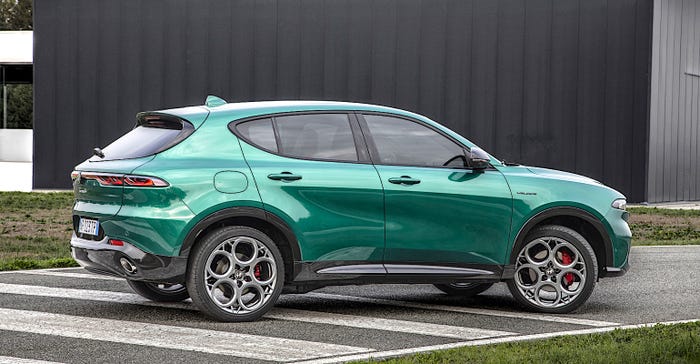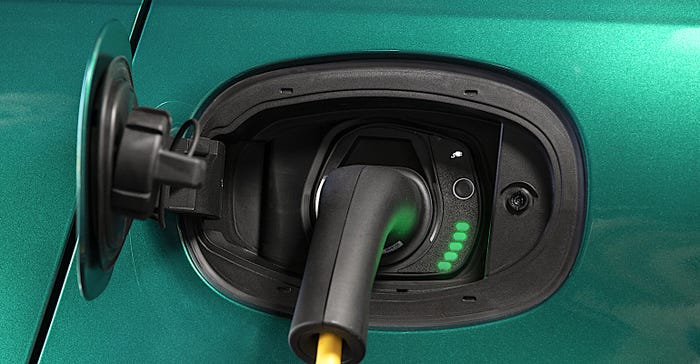SUV Italian Style: 2024 Alfa Romeo Tonale Veloce
The Alfa Romeo Tonale delivers the Italian flair promised by the brand’s sports car legacy.

Italian sports car maker Alfa Romeo has been trying to claw its way back into the U.S. market with a family of crossover SUVs aimed at American tastes in addition to its usual sports cars.
The $58,990 (including destination charge) Tonale is a compact crossover with a plug-in hybrid-electric drivetrain that hits the sweet spot of the market with a model that provides some Italian verve in a mostly bland field of competitors.
That famous Italian design sense is evident in the Tonale’s sinuous sheetmetal and gorgeous green Verde Fangio Metallic paint ($2,200, but worth it!) but it is absent in the blandly black cockpit, which would look fantastic in a tan hue to accent the green exterior. Or better yet, a green cabin, if Alfa (or any other company) had the guts to revive green as an interior color!
The Verde Fangio Metallic hue successfully navigates a path to lush green color without recalling St. Patrick's Day or British Racing Green paint suitable for a Jaguar or Aston Martin.
The tested Tonale (toh-nah-lay) Veloce (vel-oh-chay) is the top-of-the-line performance model, and the stiff ride is the price for its crisp handling. It seemed too stiff at first, in comparison to the similarly sized and priced Mercedes-Benz GLC 250.
But the trade seemed more worthwhile as the week went on and the cushy seats ensure that the Tonale is still comfortable. The Veloce’s Marelli dual-stage dampers in the Frequency Damping Suspension system provide control without getting excessively harsh thanks to their adaptability.

The Tonale demonstrates the unexpected advantage of refinement in comparison to the GLC 250. The Mercedes’ engine is disappointingly loud and uncouth for a prestige brand, while the Tonale’s 180-hp, 199-lb.-ft. 1.3-liter turbocharged four-cylinder minds its manners.
This is partly due to the car’s use of its plug-in hybrid-electric drive system that mostly eliminates any circumstances where the combustion engine might idle raucously, as the Mercedes does. The electric drive system employs a CATL-supplied 15.5. kilowatt-hour, 306-volt lithium-ion, nickel-manganese-cobalt (NMC) battery pack that powers a pair of electric motors.
The main electric drive motor is the rear-mounted 121 horsepower, 184 lb.-ft. unit that powers the Tonale when it is in EV mode. The front electric motor is a belt-drive starter/generator unit that assists the combustion engine with its added 44 hp and 37 lb. ft. while also managing invisible stop/start cycles for the gas engine.

I saw a predicted driving range of 31 miles when operating in electric mode, and the Tonale consistently delivered on that prediction during best-case-scenario summer weather driving. It takes 2.5 hours to recharge on my home 240-volt Level 2 ChargePoint station but would need about 12 hours using the provided 120-volt wall outlet charger.
When the gas motor is running, it drives the front wheels through a 6-speed Aisin F21-250 automatic transmission. A detail of the Veloce trim level is the inclusion of steering column-mounted shift paddles, but the time has passed when shifting an automatic transmission for yourself provides any performance benefit.
Another reason for the refinement and quiet in the Tonale’s cabin is the effort Alfa has put in to quell any unwanted sound. With the driver’s door open, it is easy to see the expanded foam closure between the front fender and the A-pillar that helps insulate the interior from road and engine noise.
Additionally, Alfa has applied a plastic sound-deadening panel to the leading edge of the front doors, which the company says reduces wind noise and improves door sealing. I’ve not seen this detail on other cars (not counting the Dodge Hornet, which is built on the same Stellantis SCCS platform in the same Giambattista Vico Stellantis plant in Pomigliano d’Arco, Naples, Italy) but I can confirm that the Tonale is quiet and pleasant in the driver’s seat, so it seems to deliver the promised benefits.
Like the Hornet, the Tonale eschews the back-of-the-wheel steering wheel-mounted volume and tuning buttons for the infotainment system that are used in all other Stellantis vehicles, including Ferraris. Instead, we get a crowded and confusing sea of buttons on the front of the wheel that demand the driver’s attention when adjusting the volume or changing the station.
But this same confusing approach is employed by nearly every other competitor in the Tonale’s segment, so it is unlikely that prospective customers will notice or care that the company has a better solution on its other models.
The steering wheel buttons are the only things that are the same about the Tonale as the rest of its class of largely indistinguishable rivals. So enjoy the ability to find your handsome Verde Fangio Metallic car in a parking lot and don’t sweat the volume adjustment.
About the Author(s)
You May Also Like





